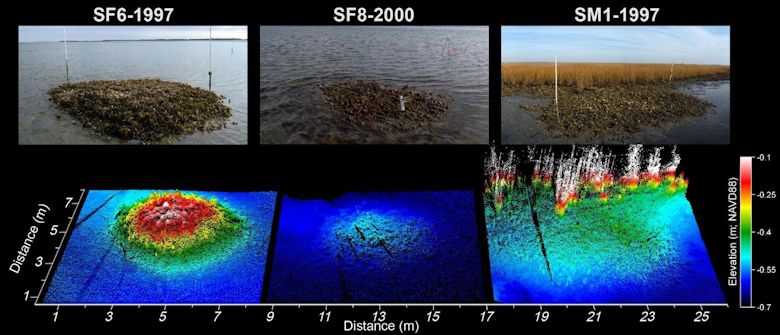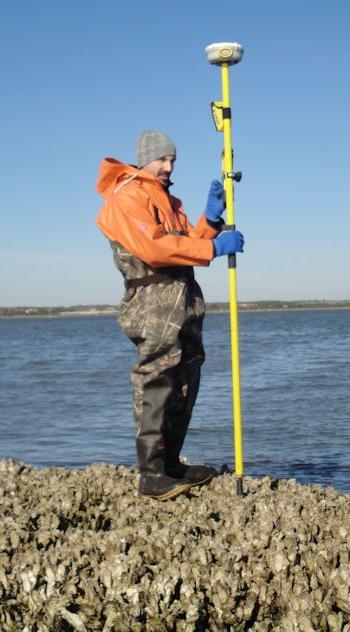Last of two parts
MOREHEAD CITY — Researchers at the University of North Carolina Chapel Hill’s Institute of Marine Sciences are looking past the ragged edges of oyster reefs to explore the role such complex habitats play in extracting and storing carbon in the estuarine environment.
Carbon dioxide, a byproduct of burning fossil fuels, is the predominant so-called “greenhouse gas” that acts as sort of an atmospheric blanket, trapping Earth’s heat. Over time, an abundance of carbon dioxide can change the global climate, according to generally accepted scientific theory. A warmer climate melts polar ice and glaciers, causing sea levels to rise.
Supporter Spotlight
 Joel Fodrie at one of the oyster reefs near Beaufort. Photo: UNC Institute of Marine Sciences. |
Containing carbon dioxide, then, is an essential line of defense against further degradation of the climate and marine resources.
Scientists are just beginning the understand the ability of salt marshes, sea grass beds and mangroves to remove large quantities of carbon dioxide gas from the atmosphere and lock it away in sediments below the plants. They call them blue carbon habitats.
Now, the UNC team points to their preliminary findings to suggest that, in certain settings, oyster reefs may qualify for inclusion on that exclusive list.
They say that shallow subtidal reefs and salt marsh-fringing reefs are net carbon sinks, especially when dominated by organic rich material and associated with moderate vertical growth.
“In such conditions, oyster reefs can sequester carbon on par with recognized carbon blue sinks,” reports Joel Fodrie, assistant professor of biological oceanography and co-principal investigator for the ongoing study.
Supporter Spotlight
Fodrie is collaborating with Antonio Rodriguez, associate professor of coastal geology, to explore carbon burial as another dimension of oyster reefs’ ecological services.
Oysters, a foundation species in estuaries, are considered nature’s engineers. These hard-working bivalves produce their shells as they mature and band together to build multi-dimensional habitats in intertidal waters. There, they filter and improve water quality, help stabilize shorelines, protect marshes, provide habitat and food sources for myriad marine life and supply delicacies for the table and livelihoods for watermen.
While oysters are celebrated for these value-added benefits, not a lot is known about oyster reef accretion, in part, because of traditional harvesting and dredging practices, Fodrie says. And, less is known about the role oyster reefs might play in sequestering carbon as a hedge against acidification of oceans associated with climate change.

Changes in reef height and volume are “seen” from left to right with high-tech tools at intertidal sandflat, subtidal sandflat and saltmarsh-fringing experimental reefs. All initially were the same size, but evolved differently over the past decade based on landscape setting. Source: UNC Institute of Marine Sciences.
Location, location, location
“There are many unknowns in oyster-reef research, like how rapidly they grow and how reef composition changes as it grows,” Rodriguez adds.
To help address the research void, the team is working in the undisturbed waters of the Rachel Carson Estuarine Research Reserve near Beaufort. There, a decade earlier, Jon Grabowski, a graduate student at the institute, built experimental oyster reefs in varying estuarine landscape settings and depths.
“Basically, we know the birth dates of these reefs,” Fodrie notes. “So we have a known starting point to measure growth at each of 19 sampling sites.”
Their interdisciplinary research approach enables them to use a combination of biological (quadrant counts for live oyster density) and geological (vertical through-reef coring and analysis) methods to compile data.
With a terrestrial laser scanner and a Global Positioning System, the team is compiling a detailed topographical map of each reef at the centimeter scale. These precise images provide data for comparisons over time.
Not all their tools are high tech instruments, though. They use a gas-powered jack hammer to pound pipe through each reef and a car jack to extract the sediment-filled pipe.
 Antonio Rodriguez uses GPS technology to get a fix on a reef. Photo: UNC Institute of Marine Sciences. |
The cores of shell and sediment, like rings on trees, help researchers calculate annual carbon burial rates as well as changes in reef composition over time.
Whether an oyster reef is a carbon source or a sink is one of nature’s balancing acts that comes down to location, location, location.
Core analyses show that oyster reefs next to salt marshes have far more carbon in the sediment between shells than those on sand flats.
In other words, reefs in messy, organic-rich matrix trend toward a carbon sink designation – even factoring in oysters’ carbon dioxide respiration. In these settings, oysters offer a fast track to capture, filter, process, secrete, vent and bury carbon, Fodrie notes.
Additionally, the research findings show that salt marsh fringing reefs facilitate localized seaward expansion of the adjacent carbon blue salt marsh habitat.
As for oyster reef accretion, initial findings indicate that reefs built higher up in the water column increase in volume much faster than those built lower in the column. These fast growers are mostly shell and the biosynthesis of shell is a carbon dioxide source.
The next step
Rodriguez is taking the lead as principal investigator for the next step in the oyster reef research project, which is focusing on natural intertidal reefs in different settings in the Core-Albemarle-Pamlico estuarine system.
“Moving into natural reefs brings new challenges because we have to develop new methods for measuring reef growth. Unlike a restored reef, we don’t know when a natural reef was born,” Rodriguez says.
“We want to see if naturally occurring oyster reefs are facilitating the evolution of marsh islands as we observed in salt marsh fringing reefs in Rachel Carson Estuarine Research Reserve,” Fodrie adds.
Ultimately, the IMS researchers would like to try out their methodology in the Gulf of Mexico or the Chesapeake Bay.
Fodrie and Rodriguez believe they are creating a framework for asking questions about shellfish reef conservation as part of the larger issue of carbon sequestration and climate change.
“The subject of oyster reefs as carbon sinks has not had its day in court, so to speak,” Fodrie says. “We would like to have our work published in an environmental journal and put it out there for other scientists to validate – or poke holes in.”
The IMS oyster reef research is funded by grants from the Albemarle-Pamlico Estuarine Program, North Carolina Sea Grant, the N.C. Division of Marine Fisheries and the National Science Foundation.








